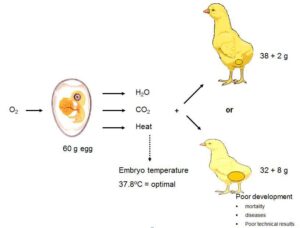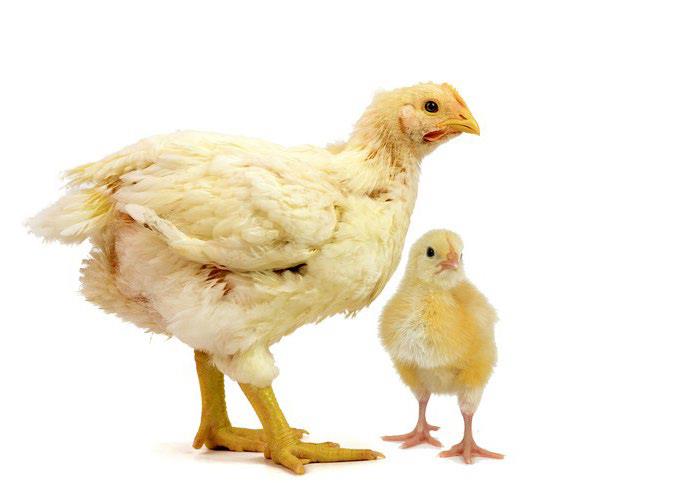The modern broiler chicken breeds have been selected over several years for fast growth and at present weigh around 2,3 kg at 35 to 42 days of age. The magnitude of growth indicates that each day during the growing period is important to achieve the target weight.
When the broiler embryo prepares for hatching, the yolk sac is internalised. This action ensures that the hatched chicks will have an adequate nutrient reserve during the first 3 to 5 days after hatching. The presence of the residual yolk sac during the first 3 days after hatching is critical for the growth and development of chicks. The absorption of the yolk sac initiates growth of the bird and a significant increase in the body weight. The presence of this yolk sac affects the initial feed intake positively, especially during the first 3 days post hatch.
When the chick emerges from the shell, the amount of yolk not utilised during incubation is present in the yolk sac as an extension of the small intestine. This residual yolk is absorbed during the first week of life (within 3 to 4 days after hatching).
How will a rapid and quick absorption of the residual yolk benefit the growing chick?
Chicks that are able to absorb their yolk sacs quickly are less likely to die in the first 7 days of life. Mortality due to yolk sac retention such as omphalitis (an infection of the navel and or yolk sac), which is a common cause of death in chicks younger than 7 days, is reduced in chicks that utilise their residual yolk sac quickly after hatching. High chick mortality is a poultry farmer’s worst nightmare.
Yolk utilisation and embryo development
A fertile hatching egg comprises shell, yolk, albumen and a viable germ. During incubation, the embryo develops its body from the contents of the egg, using energy obtained mainly by burning yolk fat. This process also produce waste products: carbon dioxide (CO2), water (H2O) and heat.
To incubate successfully, environmental conditions that facilitate this process have to be created. At hatching, a certain amount of yolk is left unutilised in the yolk sac. Yolk and albumen are used to build up the body of the embryo. The proportional quantities of energy that are lost to the environment can be summarised as “burned” (see Figure 1).
High chick mortality will reduce productivity and, consequently, reduce the profitability of the enterprise. Good performance in terms of increased growth rate on meat yield is vital in broiler production. A healthy chick easily attains the expected weights at day 7 (not less than 180 g). This milestone will set the pace for the subsequence weights gained during the lifetime of the bird.

Figure 1: Some chicks are born with more residual yolk than others. It can be expected to find a lower yolk-free body weight in a chick that has a large residual yolk; this chick also burned less energy.
Why is yolk retention an economic problem?
When the yolk is not absorbed rapidly and instead it is retained in the chick, bacteria tend to enter the yolk and cause infection. The bacteria will grow rapidly in a high protein content which provides favourable nutrients for bacteria multiplication.
In addition, the yolk sac is maintained at the temperature of the hatcher, and then at chick’s body temperature, which are the ideal temperatures for multiplication of certain bacteria. Yolk retention and yolk sac infection are considered as important causes of high mortality in chicks.
The farmer must encourage the rapid utilisation of the residual yolk once the chicks start their new life. This can be achieved in a number of ways.
Biosecurity measures must be taken as priority to ensure the prevention of infectious pathogens that may cause yolk sac infection and hence slow down the rate of yolk absorption.
Recent studies indicate that residual yolk is used up quickly by chicks that have access to feed immediately after hatching. It is important that chicks are given feed and water immediately once they are placed in the brooder. Post hatch starvation slows down the rate of absorption of the yolk, which should be avoided.
Use a quality feed, such as Tiger feed, that gives the chick the much-needed nutrients for faster growth.
Ensure brooding management such as correct temperatures, good biosecurity, and good litter to enable chicks to grow to their fullest potential. The farmer who makes sure the chicks receive the right conditions to start their new life is the farmer whose venture will be success.
Contact Barbara M Simbaya, Technical Advisor of Tiger Feeds, on +260-97-588-65-97 for more information on effective chick farming.









